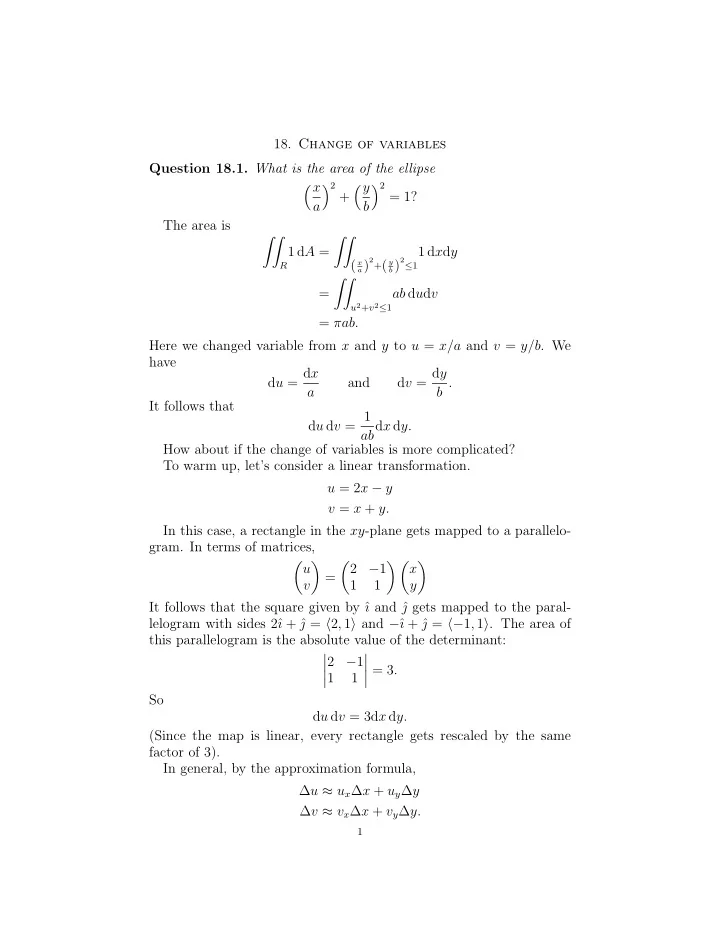

18. Change of variables Question 18.1. What is the area of the ellipse � x � y � 2 � 2 + = 1? a b The area is �� �� 1 d A = 1 d x d y 2 + ( y 2 ≤ 1 ( x a ) b ) R �� = ab d u d v u 2 + v 2 ≤ 1 = πab. Here we changed variable from x and y to u = x/a and v = y/b . We have d u = d x d v = d y and b . a It follows that d u d v = 1 ab d x d y. How about if the change of variables is more complicated? To warm up, let’s consider a linear transformation. u = 2 x − y v = x + y. In this case, a rectangle in the xy -plane gets mapped to a parallelo- gram. In terms of matrices, � � � � � � u 2 − 1 x = v 1 1 y It follows that the square given by ˆ ı and ˆ gets mapped to the paral- lelogram with sides 2ˆ ı + ˆ = � 2 , 1 � and − ˆ ı + ˆ = �− 1 , 1 � . The area of this parallelogram is the absolute value of the determinant: � � 2 − 1 � � � = 3 . � � 1 1 � So d u d v = 3d x d y. (Since the map is linear, every rectangle gets rescaled by the same factor of 3). In general, by the approximation formula, ∆ u ≈ u x ∆ x + u y ∆ y ∆ v ≈ v x ∆ x + v y ∆ y. 1
In terms of matrices � � � � � � ∆ u u x u y ∆ x ≈ . ∆ v v x v y ∆ y Then a small rectangle in the xy -plane gets mapped approximately to a parallelogram of area the absolute value of the determinant � � u x u y � � � . � � v x v y � The determinant is called the Jacobian, J = ∂ ( u, v ) ∂ ( x, y ) . Taking the limit as ∆ x and ∆ y go to zero, we get d u d v = | J | d x d y. Note that we take the absolute value, as area is always positive. Let’s see what happens if we go from Cartesian coordinates to polar. x = r cos θ y = r sin θ. The determinant is � � cos θ − r sin θ � � � = r, � � sin θ r cos θ � so that d x d y = r d r d θ, as expected. Question 18.2. Let R be the square with vertices ( ± 1 , 0) , (0 , ± 1) . What is sin 2 ( x − y ) �� x + y + 2 d x d y ? R Let’s change coordinates to u = x − y and v = x + y . Note that this has two benefits. The integrand simplifies and the sides of the square are given by u or v constant. The side from (0 , 1) to (1 , 0) corresponds to v = 1. u ranges from − 1 to 1. Similarly the four sides are u = ± 1 and v = ± 1. The Jacobian is � � 1 − 1 � � J = � = 2 . � � 1 1 � 2
(0 , 1) ( − 1 , 0) (1 , 0) (0 , − 1) Figure 1. Region of integration So d u d v = 2d x d y. � 1 � 1 sin 2 u sin 2 ( x − y ) �� 1 x + y + 2 d x d y = v + 2 d u d v. 2 R − 1 − 1 It is then straightforward to finish off. One more example. Let’s compute � 1 � 1 x 2 y d x d y, 0 0 by using the change of variable u = x and v = xy . The Jacobian is the absolute value of � � 1 0 � � � = x. � � y x � Note that x is positive over the square, so no need to take the absolute value. x 2 y d x d y = x 2 y 1 x d u d v = v d u d v. Now we figure out the range of integration. First the outer limits. What is the maximum value of v over the square? Well 1, achieved at the point (1 , 1). And the minimum value is 0, achieved at (0 , 0) . So v ranges from 0 to 1. What about u ? Well if we fix a value of v , we get a hyperbola. The maximum value of u = x is always 1. We have xy = v . The minimum value is when x = v . So the integral in uv -coordinates is � 1 � 1 � 1 � 1 x 2 y d x d y = v d u d v. 0 0 0 v 3
(0 , 1) (1 , 1) (1 , 0) (0 , 0) Figure 2. Limits for u = x 4
Recommend
More recommend